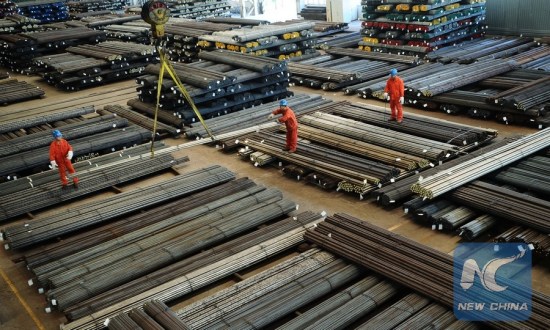
Workers are busy at a manufacture base of Dongbei Special Steel Group Co., Ltd. in Dalian, northeast China's Liaoning Province, Oct. 13, 2015. (Xinhua/Liu Debin)
According to statistics of the World Steel Association, world output of crude steel in 2015 was 1.62 billion tons, and average capacity utilization rate 69.7 percent, 3.7 percentage points lower than the 73.4 percent in 2014, which shows that the overcapacity of the world steel sector is increasing.
In view of the significant and growing capacity that exists in the global steel industry, governments of countries with big steel industries are taking immediate action to address the issue.
However, due to the divergence of views on the root of the crisis, endeavors from China, the United States and the European Union (EU) play out differently.
CHINA TAKING CONCRETE MEASURES, STIMULATING DEMAND
Addressing a high-level conference in Brussels, China's Assistant Minister at the Ministry of Commerce Zhang Ji said: "It is the slow recovery of the world economy that causes a sluggish demand for steel products, which further leads to the overcapacity issue in the steel sector."
Zhang added that any other analysis or judgment that deviates from this perception will lead to failing to find the proper solutions.
China's output of crude steel in 2015 was 804 million tons, and capacity utilization rate is 71.2 percent, higher than the world average level. China is hence making great efforts to cut excess capacity in the steel sector.
The Chinese government has ceased to license steel projects and started to close outdated plants and eradicate "zombie" companies.
China has so far cut over 90 million tons of obsolete capacity during the 12th Five-Year period. Fixed asset investment in the steel sector has kept declining in the past two years. Fixed asset investment in the ferrous metal smelt and extrusion industry in 2015 dropped by 11 percent year-on-year. Furthermore, market competition and environmental constraints have forced a number of steel mills to exit.
The State Council, China's cabinet, announced earlier this year that crude steel production capacity will be slashed by 100-150 million tons over the next five years. It is estimated that 500,000 laid-off workers will have to be resettled.
"To make sure that excess capacity will be eliminated in an orderly manner, the central government has allocated an earmarked fund of 100 billion yuan (15.45 billion U.S. dollars), which will be used to resettle workers," Zhang said.
"Not a penny of the money will be used for subsidies," he stressed.
Moreover, rather than dumping steel in other countries, the Chinese government has in recent years implemented measures such as export tariffs on some steel products to reduce exports.
"The export tariff for billet is 20 percent and for hot-rolled wire rod 15 percent," he said.
The Chinese government is also committed to vigorously expanding the demand for steel products, Zhang said.
On this front, China has taken a lot of measures such as embarking upon necessary large-scale infrastructure development projects.


















































